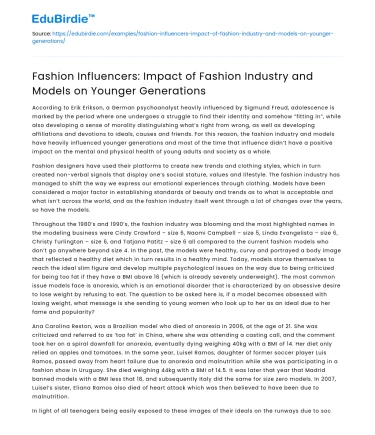According to Erik Erikson, a German psychoanalyst heavily influenced by Sigmund Freud, adolescence is marked by the period where one undergoes a struggle to find their identity and somehow “fitting in”, while also developing a sense of morality distinguishing what’s right from wrong, as well as developing affiliations and devotions to ideals, causes and friends. For this reason, the fashion industry and models have heavily influenced younger generations and most of the time that influence didn’t have a positive impact on the mental and physical health of young adults and society as a whole.
Fashion designers have used their platforms to create new trends and clothing styles, which in turn created non-verbal signals that display one’s social stature, values and lifestyle. The fashion industry has managed to shift the way we express our emotional experiences through clothing. Models have been considered a major factor in establishing standards of beauty and trends as to what is acceptable and what isn’t across the world, and as the fashion industry itself went through a lot of changes over the years, so have the models.
Save your time!
We can take care of your essay
- Proper editing and formatting
- Free revision, title page, and bibliography
- Flexible prices and money-back guarantee
Throughout the 1980’s and 1990’s, the fashion industry was blooming and the most highlighted names in the modeling business were Cindy Crawford – size 6, Naomi Campbell – size 5, Linda Evangelista – size 6, Christy Turlington – size 6, and Tatjana Patitz – size 6 all compared to the current fashion models who don’t go anywhere beyond size 4. In the past, the models were healthy, curvy and portrayed a body image that reflected a healthy diet which in turn results in a healthy mind. Today, models starve themselves to reach the ideal slim figure and develop multiple psychological issues on the way due to being criticized for being too fat if they have a BMI above 16 (which is already severely underweight). The most common issue models face is anorexia, which is an emotional disorder that is characterized by an obsessive desire to lose weight by refusing to eat. The question to be asked here is, if a model becomes obsessed with losing weight, what message is she sending to young women who look up to her as an ideal due to her fame and popularity?
Ana Carolina Reston, was a Brazilian model who died of anorexia in 2006, at the age of 21. She was criticized and referred to as ‘too fat’ in China, where she was attending a casting call, and the comment took her on a spiral downfall for anorexia, eventually dying weighing 40kg with a BMI of 14. Her diet only relied on apples and tomatoes. In the same year, Luisel Ramos, daughter of former soccer player Luis Ramos, passed away from heart failure due to anorexia and malnutrition while she was participating in a fashion show in Uruguay. She died weighing 44kg with a BMI of 14.5. It was later that year that Madrid banned models with a BMI less that 18, and subsequently Italy did the same for size zero models. In 2007, Luisel’s sister, Eliana Ramos also died of heart attack which was then believed to have been due to malnutrition.
In light of all teenagers being easily exposed to these images of their ideals on the runways due to social media and how globalized the world became due to the web, and knowing that teenagers thrive on creating cliques and circles of common interest by communicating their values non-verbally in the form of clothing and image, what exactly is it the fashion industry is delivering to the vulnerable young minds that should be focused on building skills and personalities and enriching their minds with more arts, culture, human and environmental causes? Weighing down mental development to body image and looks would be beyond shaming to how the industry is driving youngsters further away from self-development and rather putting them on the path to self-destruction.






 Stuck on your essay?
Stuck on your essay?

